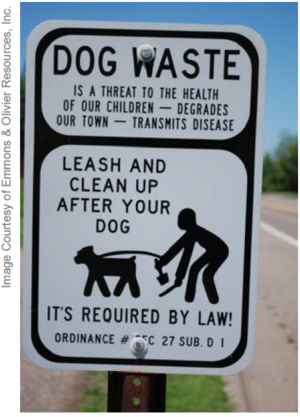
MS4 fact sheet - Reducing Pet Waste
Pet waste left uncollected is unsanitary and disagreeable for users. It contains pathogenic bacteria and other parasites. When pet waste is washed into our lakes and rivers it decays in the water, depleting oxygen levels and releasing ammonia, which can be harmful to fish and other aquatic organisms. Pet waste also contains nutrients that foster weed and algae growth. Elevated bacteria levels in lakes and rivers caused by Escherichia coli (E. coli) can cause unsafe conditions for swimming and recreational activities.
This fact sheet provides guidance on developing a community pet waste management program.
Contents
Benefits and pollution reduction
Pet waste management results in cleaner parks and neighborhoods, with improved aesthetics and lowered potential for diseases to spread. Reducing the amount of uncollected pet waste reduces a significant cause of stormwater pollution.
Program development and implementation
Programs designed to combat poor management of pet waste fall into three broad categories. Municipalities often create programs that overlap these categories for optimal results.
Awareness campaigns (pet owner-based)
Programs are designed to overcome educational barriers. Owners are educated about the health risks and natural resource impacts associated with not cleaning up their animal’s waste and are informed of their responsibility for finding suitable methods to pick up after their pet. The City of Minneapolis has implemented the “Canines for Clean Water” awareness campaign. Throughout the summer, the city sponsors dog oriented activities and education about keeping their waterways clean.
- Brochures/fact sheets Informational sheets are mass-mailed to educate residents of the health risks, natural resource impacts and applicable ordinances/fines. The brochure should also outline the proper handling and disposal of pet waste. Brochures could be provided at public kiosks or city offices, attached to park signage (see image above) as well as displayed at pet supply outlets and veterinarian offices.
- Park signage Located at park entrances to alert residents of the proper disposal techniques and/or park design features for pet droppings.
Pet waste control ordinances (management-based)
A municipality may introduce a law that requires pet owners to pick up after their pets or risk receiving a fine.
- Pet Waste Ordinance Model Language - Model ordinance language for municipalities to prohibit pet waste
Park design features (management-based)
- Collection systems - The simplest addition to a dog-friendly park are pet waste collection systems, which hold plastic bags for owners to use to pick up waste, and which have garbage cans placed in close proximity to bag dispensers and park exits. Bag dispensers should also include educational signage.
- Doggy loos - Pet feces disposal units are placed in the ground, which operate by foot-activated lids. Decomposition is quick, and messy cleanup is avoided.
- Pooch patch - Upon entrance into the park, the dog is introduced to a telegraph pole, surrounded by a scattering of sand. Dogs are encouraged to defecate on the patch, and bins are close by for owners to dispose of their dog’s waste.
- Long-grass principle - Parks can have areas where grass is not mowed where pet owners can take their dogs to defecate. A height of around 4 inches is necessary for the feces to disintegrate naturally without stormwater runoff. Long grass areas, however, should not be placed in close proximity to overland flow paths, stream channels, lakes, drinking water wells, and stormwater drainage inlets.
Maintenance considerations
- Collection Systems: Regular refuse collection and resupply of pickup bags.
- Doggy Loos: These disposal units are installed in the ground and decomposition occurs within the unit. Minimal maintenance is required (occasionally add water and non-toxic digester powder for continuous break down of waste).
Typical cost
The cost of reducing pet waste varies on the intensity of the program and control activities implemented. The most popular control method is via ordinance, but municipalities must consider the cost of enforcement, including staff and equipment requirements. Awareness campaign costs are determined by the quality of materials produced and the frequency and method of distribution. Park signage may have higher initial capital costs, but can last for many years. Signs may also be more effective, since they act as on-site reminders to dog owners to clean up in parks. Collection systems can cost anywhere between 💲60 and 💲400. The pickup bags purchased in bulk cost 5¢–15¢ each.
Interesting websites
- The Poop Problem: What To Do With 10 Million Tons of Dog Waste (Op-Ed) - LiveScience
- Dog Poop – Its Environmental Impact - Green Blizzard
- Do You Scoop The Poop? - RI Stormwater Solutions
- Toxic Dog Waste - Doody Calls Pet Waste Management
- Pet Waste:What’s the problem? - Pacific Shellfish Institute
- The Scoop on Dog Waste - Ecological Landscape Alliance
